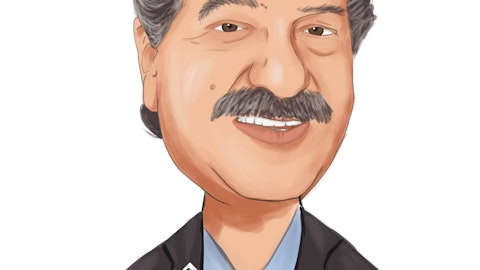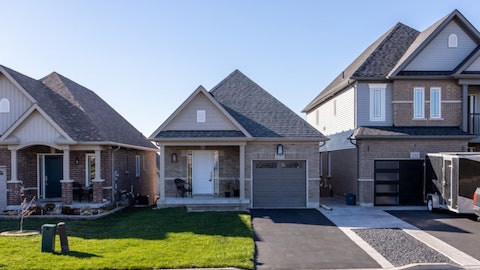Adam Kramer : Got it. That’s really helpful, guys. And just the last one, maybe just on Hawaii and tourism. What’s kind of the view on when you could see kind of a full recovery there? Or is that something that maybe is only kind of in a bull case and I shouldn’t really think about the timing and kind of base case?
Ernest Rady: Well, the best answer is we really don’t know because we don’t have any control over it. But as Bob pointed out, eventually, Hawaii will recover, Embassy Suites is a fantastic property. We keep it in the first-class shape, has an excellent reputation. Do you want to add something, Bob?
Robert Barton: Yes. Adam, really, it’s coming down to the Japanese yen. It’s been sticky at about 148. It’s gone as high as 152 . It’s down to 148. In pre-COVID it used to be 105 to 108. So there — our Japanese guests are factoring that, that’s an additional cost to that. So when we were over last over in Hawaii seeing our team at the end of December, and we saw a Japanese guests over there, but it’s a much smaller percentage. So we think — it’s not that we think, we know that it’s just a matter of time when that occurs, but we don’t know, as Ernest mentioned, we just don’t know that timing at this point.
Ernest Rady: In the meantime, the domestic market has filled the void to some extent, but not with the same revenue that would come if it were the Japanese.
Adam Wyll: Adam, this is Adam. I saw a report yesterday that said the Asian tourists to Oahu we’re at about 20% of the pre-COVID levels last year. So plenty of room to grow. Just timing is uncertain.
Ernest Rady: We got 2 Adams on the phone, things must be going — it’s a great day.
Operator: [Operator Instructions] The next question is from Haendel St. Juste with Mizuho.
Ravi Vaidya : This is Ravi Vaidya on the line for Haendel. I hope you guys are all doing well here. Just a question about the office same-store portfolio. How long do you think this will remain negative? And do you expect an inflection in the back half of the year into 2025? Or like what’s kind of driving the negative same-store office projection? Is it the timing of the speculative leasing?
Ernest Rady: That’s a really good question to ask, and I’ve really got glad I’ve got Steve to answer the question because I don’t really know. Steve, do you have that feel?
Steve Center: Well, you hit on — and Bob remarked on it in our comments, it’s really — if a lease isn’t signed by Q1, we just pushed it out to ’25 because permit is taking up to 6 months depending on the municipality and the construction can take 4 to 6 months as well depending on the size of the [indiscernible]. So we’re just being conservative in that regard. That being said, we’ve got smaller leases and smaller — I should say, smaller suites that are ready to go, and those could happen much more quickly. But we just erred on the side of caution to be honest with you, given the timing that I mentioned.
Ernest Rady: And I think it’s safe to say the markets we’re in, we’re doing as well as anybody. Is that a fair statement?
Steve Center: I would say we’re doing better.
Ernest Rady: So if it can happen, Steve is going to make it happen.
Ravi Vaidya : Got it. Just about your multifamily portfolio, the occupancy increased pretty dramatically sequentially, but the average rent per unit decreased a bit. We’re hearing broader conversations and broader discussions of incremental supply and how it’s weighing on landlord pricing power. Is that kind of what’s happening here within your multi portfolio?
Ernest Rady: Well, one of the things that’s happening is our expenses are going up, and then I’ll let Abigail answer the revenue side.
Abigail Rex: In San Diego, there were approximately 3,000 units that came online to the rental market. So rents have been decreasing a little bit because renters are competing as our property managers for new renters are offering concessions trying to fill their lease-ups. So we are competing with that, although our multifamily here, the rental rates, we’re trying to push them. The team mentioned that we’re continuing to reposition properties, and we’re offering great experiences for the residents, and they have great big floor fleets. So we’re going to continue pushing as best as possible given the market.
Adam Wyll: And Ravi, Q4 is traditionally a slower leasing period for our multifamily. And so as Abigail has mentioned, occupancy rates soften a little bit.
Ernest Rady: What’s happening is there’s more competition as Abigail pointed out, and we see insurance costs going up and labor costs going up. So it’s a bit of a squeeze, but they’re great properties. And if you look at the last 10 years, they’ve been very profitable and likely the next 10 years will produce comparable results, but there will be hiccups.
Ravi Vaidya : Got it. That’s helpful. Just 1 more here. Within your retail portfolio, can you talk about retailer demand for more space. How you — how is pricing power tending and maybe your tenant credit risks and many — what are some of your watchlist tenants at the moment?
Adam Wyll: I think as you heard in the script, Ravi, our retail properties are performing well. They’re and dominant locations right now. So there’s quite a bit of interest. Of course, we don’t have as many properties as some of our retail peers. So we don’t have a whole lot expiring this year. In fact, I think we only have 1 tenant left on the roster this year that’s over 10,000 square feet, which is one of our Old Navy’s at Alamo Quarry, which is performing incredibly well. So we’re feeling really good about the retail portfolio right now. We know nothing is perfect, but everything is trending well. You may have heard Bob mention that we have some reserves around retail. And like last year, we’re just trying to be a little more conservative, not knowing how things shake out, say, for example, with — we mentioned we have a deal with Rite Aid, but we still put a little reserve around those guys not knowing if they successfully emerge or not, [indiscernible] has been having some challenges.
We have 3 of those locations. We put a little reserve around those guys. We may be wrong on those, and we hope we are but they’re current on rents currently. And then we have 1 small format theater Angelika at Carmel Mountain Plaza that we’re just keeping an eye on. We renewed them. But these are — when we go through them, we try to figure out what are the probabilities and so we put a little reserve on them and just hope they keep paying rent and they figure out their finances. So it’s a way for investors or analysts can run their own numbers on whether we’re being overly conservative or not. But like Bob said, we’d rather under promise and over deliver. But otherwise, we feel really good about our retail properties well put.
Operator: This concludes our question-and-answer session. I would like to turn the conference back over to Ernest Rady for any closing remarks.
Ernest Rady : Again, thank you all for your attention and your interest. My late father who was a gynecologist used to tell me “When times get tough, the tough get going.” Things are not as perfect as they have been in the past but we have a very competent management team, great properties, liquidity, and we’ll get through this as well as anybody and hopefully better than anybody else. So again, thank you for your interest and your confidence.
Operator: The conference has now concluded. Thank you for attending today’s presentation. You may now disconnect.




